A very sad day for any Dan Armstrong enthusiast. When I first laid eyes on this instrument my immediate thought was 'OMG'...
someone had taken the body and removed the cutaway horns using a band saw! It was at that moment that I realized I had
already christened this instrument the 'Dan saw' guitar.
From what I can tell, about the only conclusion that can be drawn is that the owner wanted to get to the upper frets much more easily
and decided the only way to do that was to alter the body style. Not only were the cut-away horns removed, but it also appears that
material was removed from the sides of the body as well. At upper left, notice how the acrylic body is no wider than the scratchplate on
the side where the Dan Armstrong · Ampeg lettering resides. Likewise on the opposite side, or the top side, the clear
acrylic material is also removed - to the point that part of the sliding pickup's channel is cut into - and now meets the edge.
The cutting of the body didn't stop at the sides either. if you look at the bottom of this instrument you will notice that it has a single
strap pin located directly in the middle of the body with no visible signs of holes drilled and tapped for the usual two pins. As you may
have already surmised, the bottom of the acrylic body was trimmed to evenly follow the curvy sweep of the scratchplate. With this much
material taken away it's not surprising that the holes for the original strap pins are no longer visible, for they no longer exist. Given
the fact that this amount of mass has been removed I can't help but wonder if the instrument is now 'neck' heavy'.
At upper left & right, notice the relocation of the upper strap pin. This is not surprising - but as can be seen at upper right, a drilled
& tapped hole on the other side of the body for a strap pin seems rather odd.
At left, the necks serial number of A898D pretty much verified what the remaining pieces of the instrument had been telling me - that this was,
sadly, a fairly early model. At right, though the headstock has the smooth, un-textured faux-wood veneer, it is finished out with Grover Rotomatic
tuners. Featured in the hardware section in more detail, problems from Schaller forced a near permanent change to the Grovers. The existance of them
on a fairly early dated model as this may help to provide us, loosley, with a time frame of approximately when the Schaller tuners dropped off and
the Grovers entered the scene. With few exceptions they would remain the stock tuner with Schallers being seen sporadically only near the end of
the production of these instruments.
On the Links page of this site is a link to a video called 'Doug vs. The Dan Armstrong' where he admits cutting the 'horns' off of his plexi so that he
could more easily access the upper frets. I cannot help but wonder if this is that guitar.
At left is an interesting mod. Ironically it doesn't involve altering the body but rather the tailpiece which is replaceable. In fact, at the time
of this writing there is an original tailpiece and rosewood saddle for sale on one of the auction sites.
At left, and seen from the top, extra slots were machine-cut into the tailpiece to accommodate forward and backward travel of six individual
custom made saddle pieces. Each saddle piece employs 2 set screws. The screws seen at top tighten the saddles down in place once the proper
intonation is achieved. String slots are carved into each saddle.
At right, and seen from the bottom, the other pair of screws, I believe..... (tho I could have them reversed) go through the saddle pieces to keep them
in place within the machined slots on the tailpiece. The bottoms of these screws can be seen back on thr photo at left, lying flush with the tops
of the saddle pieces, just next to the string slots.
I would think that the saddle pieces would have to be machined with differing heights to accomodate the 9.5º radius of the fingerboard
(the fingerboard radius can be seen in the Hardware section) but maybe they just cut the outer string slots a bit deeper to accommodate for
the radius, it's hard to say. All in all, it's a unique design that could easily be reverted back to stock providing the rosewood saddle was saved.
If ever reversed, about the only thing that would show would be a few slots that were cut in the tailpiece, which would be rather minor.
At left, a bass modded with the installation of creme colored P-Bass type pickups. Notice too the added mini-switch. It's unknown what the
switch does. At right, I'm guessing a custom made holder complete with equally custom fabricated electrical connections lie where the original
Dan Armstrong pickup was.
At left, and somewhat appropriate, this bass utilizes a clear plexiglass thumb-rest, while at right, replacement tuners have been installed
in a very unusual 'upwards' manner relative to the headstock.
At left a very unusual mod consisting of a unique custom made tailpiece with a tunable bridge. Notice too, a replacement humbucking pickup
lies where the original pickup was. The coil windings are easily seen as is what somewhat resembles a black pickup ring.
As I looked the photos over and over again, something else seemed odd to me for a few seconds. Then it hit me that the routed channel for the
ball-end of the strings was way back. And as I quickly shifted my eyes upward I also noticed there was no sweeping scoop in the acrylic body
for interchangeable pickups.
At right, I put the ole 'V8' slap to my forehead for not recognizing earlier that this was originally a bass guitar body that
had been modified to be a Dan Armstrong six-string guitar. In the enlarged view, I managed to discover that a CT pickup was employed at an
earlier time. You can click here if you wish to see it. Apparently, a more powerful
pickup, without the hum was desired. It is unknown what type of humbucker this is.
But then I noticed another oddity. Clearly this was a bass body as the factory routing for the original tailpiece can attest to. Why is it,
then, that there are no drilled and tapped holes for the screws that secure the factory installed thumb rest? Also, notice that this instrument
sports a guitar scratchplate, not a bass one. As seen in the hardware section of this site, the guitar scratchplate, unlike the bass plate,
curls around the pickup just a tad at the back. This feature is the only difference between the guitar and bass scratchplate. Otherwise the
plates are identical. Even the holes for the scratchplates mounting screws are the same.
I have, what I think may be a reasonable theory to it all. It came to me when I realized that the 'new' custom bridge/tailpiece is positioned
right up against the pickup - exactly what one would expect on the guitar model. For intonation purposes, I believe this instrument also sports
an original Dan Armstrong six-string guitar neck.
I believe that this is a 'parts' guitar. Why? Because it is widely known when Ampeg ceased production of these instruments in 1971 that
literally everything even remotely relating to the Dan Armstrong guitars and basses were sold off to Lou Rose of Lou Rose Music. According to
Steve Constantelos - a former Ampeg engineer "most of us were surprised when we came to work one day and were told that production of these
instruments had come to an end, and to cease operations." Steve went on to say how Lou Rose bought up everything relating to the Dan
Armstrong acrylic instruments.
As such, I believe a bass body that was close to completion, was just one of the many parts acquired from Ampeg by Lou Rose. Likely, the
employees on the production floor at Ampeg hadn't yet drilled holes into the body for a thumb rest when everything shut down.
As to the neck, unlike most other manufacturers the necks for both the Dan Armstrong bass and the guitar models are, for the most part,
identical. Totally identical on them is the tongue. The acrylic bodies are routed to accept the tongue from either neck, as they have the same
dimensions, including the bolt holes. The only real difference in the necks are their length - which is normal - and why the routing for the
original bridge/tailpiece can be seen on the body. As to a Dan Armstrong guitar neck, one could easily had been purchased by Lou Rose.
As to the CT pickup that was on the guitar before - it has since been replaced by a humbucker of unknown make. The pickup ring, or surround, looks
to be of a custom make, but I can't be certain. Lastly, the hole for the toggle/selector switch on the guitar scratchplate has a brushed closure
type cap that nicely matches the aluminum knobs. As to the knobs themselves, no doubt Lou had purchased plenty of them. He also had plenty of
guitar scratchplates, some even complete with pots and wiring.
At left and right, A Dan Armstrong plexi bass that's had its scratchplate changes to black, no doubt due to breakage in & around the output jack.
The headstock veneer is still the faux-wood material that, at one time had matched said scratchplate. A third knob has been added and is advertized
as a 'blend knob' which has been put in place of the original selector switch.
At left and right, the seller states that the original pickup went dead and so a custom made pick-up was created and hand-wound
by Pete Biltof at Vintage Vibe Guitars. Apparently the look and sound of the original pickup was duplicated. Seen here, a large matching black
pickup ring surrounds the pickup. Notice too, that part of the scratchplate was removed to accomodiate the ring. At left, notice the thumb-rest
is missing.
At left and right, the headstock for this bass has also been slightly modified with the installation of black tuners that were made
for basses that do not have tuners on both sides of the headstock.
At left, a Dan Armstrong bass that was, according to the owner, routed out for a Badass bridge at one time but has been thoughtfully restored to be
closer to the original. Notice the routing of the acrylic behind it. Notice too that the pickguard has been replaced with a newer one, as it's positioned
a bit far from the pickup, for the pickup connection screws are visible. Also the plate curls around the pickup - meaning this is a scratchplate from the
guitar model as the original basses didn't curl around the pickup.
The white Dan Armstrong · Ampeg name on the scratch plate seems exceptionally bright even for a newer scratch plate. Equally bright is
the brown resin that encases the pickup. It's more of a tan color than brown. The seller claimed the pickup is original and by the look of it I have to agree
but I can't explain it. At right, the backside of the pickguard has metal shielding applied - again consistent with a newer scratchplate. Notice the replacement
strap pegs as well as a missing lower peg. Lastly, a Phillips 6/32 screw stands in for an original pickup thumbscrew.
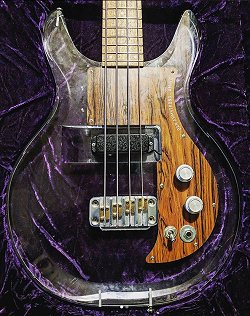
|
At left, a re-issue Dan Armstrong bass that's been modified with what appears to be a single coil pickup screwed down into the acrylic body.
The original bridge/tailpiece has been replaced with a tunable unit made by Godfrey Guitars which is the type of mod that I like, for it secures
to the body using the factory screws and is machined to anchor to the body using the factory holes - thus making it a cinch to put back to stock.
Notice the washer behind the output jack as it helps to both cover up breakage of the scratchplate while at the same time help provide some additional structure
in this area. Lastly, the thumb-rest and a strap peg has gone missing.
|
At left and right, a Dan Armstrong guitar that's been modified with the installation of a Gibson harmonica style tune-o-matic bridge and
stop tailpiece. The scratchplate has been routed out for the studs of the tailpiece. Notice that the scratchplate has also been cut into
two pieces. It is unknown if this was done to allow easier access to the control cavity or if there was some additional damage to the scratchplate
as there is the usual damage around the output jack. Notice too, that at one time the upper cutaway horn adorned a strap peg.
At left, another usual mod with the addition of a tunable bridge and replacement humbucking pickup. In the enlarged view, it's unknown what type of
bridge/tailpiece is employed but the pickup appears to be Seymour Duncan 'Invader' which is wired straight through - from pickup to output jack with only
the tone and volume controls in between, for the selector switch is missing, leaving a hole in the scratchplate. Notice two chrome plated 'Tele' looking
control knobs have replaced the aluminum originals.
On the right, and from the backside, the heads of the replacement pickup mounting screws can be seen as well as the modifications to the acrylic in and
around the bridge/tailpiece. Notice the change in the wiring which can be seen and is very basic after the removal of the switch.
At left, the headstock is fitted with Schaller tuners that appear to be pitted. At right, the backside of the headstock shows that these are not the original
tuners as there are holes drilled for set screws for what was likely a set of Grovers originally.
At left, what I call the 'Swap' mod - as the background is rather interesting. It's also a more forgiving mod, to me anyway... as it doesn't alter anything. In fact,
it's not really altering anything much, but rather an exchange of parts. As seen at left, the neck from an Ampeg AMG100 BLD model has been swapped over, and onto an
Ampeg clear acrylic re-issue model. In addition, the black scratchplate from the AMG100 has also been swapped over as well.
At right, because the AMG100 instruments were made at approximately the same point in time, the necks on the AMG100 guitar and the necks on the clear acrylic model produced
during the 2006-09 were, insofar as anchoring purposes go - identical. Necks from both models employed the same T-Nuts to secure the neck to the body. Given the same scale
length, number of frets and more, it's a simple matter to swap out different necks like this.
At left, the AMG100 headstock in its natural finish, showing the usual Ampeg 'a' decal. The black truss rod cover matches the scratchplate on the guitar, while at
right, the Grover tuners can be seen.
At left, it appears that the volume knob has been changed to a clear speed knob, perhaps to differentiate it from the tone knob while playing and
singing. Notice the smaller selector switch that the AMG100 models employ. At right, the AMG100 neck seats perfectly into the machined cavity of
the acrylic body.
At left is quite a mod. I'm guessing a massively broken scratchplate led to a new metal plate with matching headstock veneer that can be
seen in the enlarged view. Notice too, in that view, the truss rod cover is missing. Also notice a machined matching nut as well as a
locking nut behind it. Back at the body, notice two matching machined metal knobs for volume and tone controls as well as an output jack,
but no pickup selector switch. Lastly, it appears the acrylic body has been routed behind the tremolo bar for whatever reasons.
On the right is an interesting mod. Better seen in the enlarged view, an extra piece of the faux-wood scratchplate has been cut and shaped
into a rectangle and placed on top of the existing plate. Likely, this is a patch of sorts, where the scratchplate probably had the usual
breakage around the output jack. This extra piece was likely added to shore everything up. One can only wonder where a matching piece of
faux-wood veneer was acquired, but it appears to do the job.
Notice how there are no screws securing this patch down. Likely, either some form of adhesive was used, or..... perhaps just pressure, as
a hole was drilled in the middle of the patch for the output jack. Depending on whether the original plate was glued back together with
epoxy etc. then just tightening the jack down through both the original plate, as well as through the patch piece - it could just provide
enough pressure to hold everything in place.
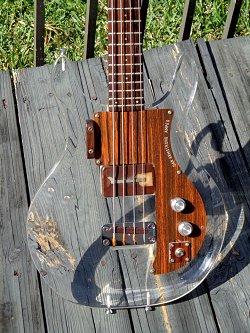
|
A Dan Armstrong bass that's been a little bit modified, more like a repair - with a similar piece of faux-wood veneer on top of the original
faux-wood scratchplate at the output jack. Unlike similar patches that use epoxy, this one utilizes four screws, one in each corner of the
added piece. It's very possible, and quite likely that epoxy was used underneath this patch as well.
In the enlarged view, if you look closely you can still see some of the original breakage that occurred and did not get covered. It's at
the top (in this image) and virtually dead center. One can only wonder why a larger piece wasn't used so that all breakage could be covered.
It wasn't until I took a closer look that I had some answers. In the extra large view we now know where the extra material came from. We know
because of the white letters which gives it away. It clearly shows the letters AM-FM. So apparently someone must have had a
junk radio that had faux-wood material and a small piece was used as a patch.
|
Also seen in that extra-enlarged view, if you look at the patch at approximately 12, 3 and 5 o'clock - is breakage that could not be - or just
plain wasn't... covered up. One can only assume that there simply wasn't enough 'radio' material to cover everything. At the 5 o'clock breakage
area, the screw in the plate is also the spot where the original scratchplate screw was before the break. So, that particular screw is now doing
double duty - serving as the original screw but also makes up one corner of the patch. Even then, the damage goes past that screw and all the
way down to the end of the plate.
At the lower left of all this, notice one of those screws that has a washer molded right onto the screw head. The use of this type of screw is
obvious as it is securing down yet another portion of the scratchplate that's been broken off. Last, but not least, notice the rosewood saddle.
Maybe it's just me, but it does not look like a stock Ampeg rosewood type bridge saddle. Scratchplate breakage not withstanding, it's still a
very clean looking instrument.
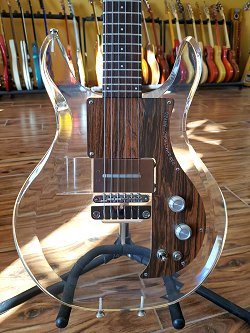
|
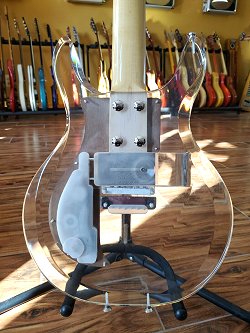
|
At left and right, an early Dan Armstrong with a serial number of A482D that's been modified. Better seen in enlarged view, the original
tailpiece has been cut 'in-half' to allow room for a tun-o-matic type bridge. In the enlarged view, you will see a ground wire running from
the control pocket to the bridge. Oddly, the wire from the pocket to the tailpiece is missing. Also seen is some minor breakage around the
selector switch. At right, and better seen in enlarged view, the routing in the acrylic body for the bridge can be seen.
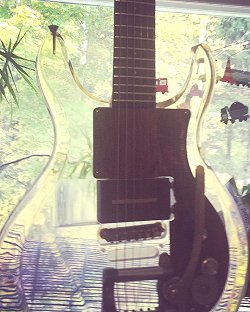
|
At left, an Armstrong plexi with a Bigsby and Tun-O-Matic style bridge. Kind of a dark image , but notice the routed section in the acrylic
as well as the drilled & tapped holes where the original tailpiece and two rear mounting screws used to be. In the enlarged view, notice a
large washer behind the output jack for the 'usual' breakage.
|
At left and right, another unforgivable mod. I guess I just don't understand - if someone wanted a Gibson SG then why didn't they just purchase
an SG? As seen here, someone carved the cutaways to give it the sharp pointed SG style cutaway horns like that on an SG, while the remainder of
the body is cut and crudely shaped somewhat like that of an SG as well. Notice too, how the strap peg is placed on the backside of the upper
cutaway horn.
At left, and instantly obvious is the factory scratchplate has been replaced with a clear plastic one that, according to the seller, is so thick
that it "interferes with fretted notes beyond the 22nd fret." The original wiring is long gone and has been replaced with a battery
powered circuitry. A switch, and an extra potentiometer has been added to the electronics and scratchplate. At right, additional routing of the
control cavity, both in depth and width has been done to accomodate the additional electronics as well as the battery.
At left, and right, the sharp cutaways are instantly obvious, as is the strap peg at right.
According to the seller "The tuners have been replaced with a set of gold Gotoh gears and the front of the headstock seems to have been
refinished."" The question here, is why? The seller ends with "The truss rod cover with its wood grained finish looks original."
Sadly, it's just one of the few things that is still original. The only reason to purchase this guitar would be for the remaining stock parts.
continue
menu
Names and images are TMand © Dan Armstrong / Ampeg. All rights reserved.
All other names and images are TMand © of their respective owners. All rights reserved.
|

